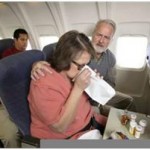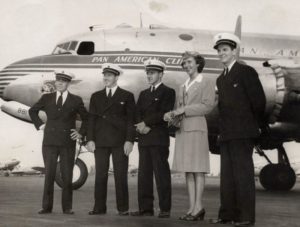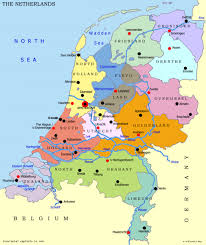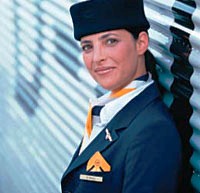domingo, 31 de julho de 2011
There’s no respect flying domestic
(An excerpt from the book, Cruising Attitude - first draft…)
People with regular jobs aren’t quite as understanding when flight attendants complain about their lives. Our bad days automatically sound good if we’re able to toss in words like Paris, Buenos Aires, Rome, and Madrid into random sentences on a regular basis. Even if we don’t work to international destinations people automatically assume that we do. Unfortunately the majority of flight attendants get stuck working to cities like Dallas, Dulles and Denver. Not that there’s anything wrong with Dallas, Dulles, or Denver. It’s just that when the video player goes on the fritz and we have to do a manual safety demonstration, it normally doesn’t include the bit on how to properly inflate a lifevest since most US airports aren’t located over a body of water.
Seniority is everything at an airline. Those who have it take full advantage of it by flying international routes, making the rest of us suffer in their glamorous wake. I don’t blame them. One day I, too, hope to have enough years under my thin, blue, belt to work all the best trips and make junior flight attendants (and some passengers) cry by not retiring when they think I should. Why retire when all I’ll have to do is work two five-day trips to Narita each month? Gardening is nice, but so is eating sushi with real wasabi and shopping in the Ginza district! Until then you’ll find me laying over in Saint Louis with nothing to do except browse the Hustler Store or go to Denny’s for the early bird, super bird, special. Both establishments are located directly across the street from our airport layover hotel, which is also located right next to a cemetery that can double as a running path. Such is life.
Whenever I tell anyone where I’m going or where I’ve been, I immediately see the disappointment in their eyes. There’s no respect flying domestic! It’s like comparing Wal-Mart to Barney’s. My friend Melanie can always tell an international flight attendant from a domestic one based on their shopping bag alone – Harrods vs Trader Joes - hanging off the back of their rollaboard. No one wants to hear about my layover in Orange County when my roommate is talking about laying out on a beach with its own Barry Manilow song. Hey, I get it, because I feel the same way about foreign based flight attendants. Their lives can’t be all that much different from mine, yet they seem so much more exciting and glamorous even when at the end of the day they end up on the opposite side of the same hotel pool.
Perhaps it’s the accent that makes the grass seem so much greener. Maybe it’s the uniform. Something tells me the Air France flight attendants aren’t wearing skirts made in China or pants made in Poland with blazers made in Guatemala, which explains why my navy blues don’t always match up and why I look like one of the Bad News Bears whenever I’m surrounded by my stylish foreign counterparts. For awhile I wondered if the airline I work for wanted our uniform pieces designed by every country we flew to. Or if the lavatory maintenance department had been given authority over uniform quality checks. When I called the uniform department to complain about my mismatched blues, I was informed of what I already knew. None of the new blazers matched any of the old uniform pieces. Solution; order a new dress. Yeah, easy for them to say considering they weren’t the ones stuck paying for a majority of the uniform pieces out of pocket. The polyester tent dress alone costs ninety-nine bucks! And that doesn’t include the cost for alterations. Which is why I continue to wear the purple-y dress with the midnight blue blazer, and why I’m sure passengers think I’m color blind instead of broke. The good news is I have nothing to do with the horrible fashion faux pas. If I look like crap it’s the company’s fault. On my days off, well, unfortunately that’s my fault…..
sábado, 30 de julho de 2011
Kinds of turbulence.
There are four types of turbulence: light, moderate, severe, and extreme.
Light turbulence causes a slight, rapid and somewhat rhythmic bumpiness without appreciable changes in altitude or attitude. Sometimes pilots refer to it as light chop. It's the kind that rocks babies, and even a few overly worked flight attendants, to sleep. The seat belt sign may be on, but flight attendants are still able to conduct the food service with little to no difficulty.
Moderate turbulence is a little more intense. It causes rapid bumps or jolts without changes in aircraft altitude. Passengers will feel the strain of their seat belts. Unsecured objects in the galley may dislodge. Conducting a food service or checking for seat belt compliance is difficult.
Severe turbulence causes large or abrupt changes in altitude. The aircraft may be momentarily out of control. Passengers are forced violently against their seats. Walking is impossible. If flight attendants haven't strapped into their jump seats already, we may not be able to do so and we'll have to grab the nearest available passenger seat. If there's not one open, we'll sit on a passenger – any one will do. Make sure to hold on to us tightly.
Extreme turbulence rarely happens, but when it does it will violently toss an aircraft about, making it practically impossible to control. Structural damage is possible.
Moderate turbulence is a little more intense. It causes rapid bumps or jolts without changes in aircraft altitude. Passengers will feel the strain of their seat belts. Unsecured objects in the galley may dislodge. Conducting a food service or checking for seat belt compliance is difficult.
Severe turbulence causes large or abrupt changes in altitude. The aircraft may be momentarily out of control. Passengers are forced violently against their seats. Walking is impossible. If flight attendants haven't strapped into their jump seats already, we may not be able to do so and we'll have to grab the nearest available passenger seat. If there's not one open, we'll sit on a passenger – any one will do. Make sure to hold on to us tightly.
Extreme turbulence rarely happens, but when it does it will violently toss an aircraft about, making it practically impossible to control. Structural damage is possible.
Parts inside the Aircraft
Flying can be an exciting as well as a jumpy and stressful experience for those flying for the first time. While you may be excited about travelling by air, there is also this lurking fear that you may not know what to do. Knowing what to expect as you enter the cabin can be reassuring.
When passengers enter the aircraft they are seated in what is called the cabin area. This area is divided into different sections for business and economy class passengers. The first row and the emergency exit rows are generally preferred by tall people who need more leg room. Front rows are also preferred by those who do not want a bumpy ride since the movement of the aircraft is exaggerated in the rear rows.
The cabin area also includes the galley where the food is prepared, seating area for flight attendants and storage space that is used to carry food and beverages and other essential items. The space in between the seats is known as the aisle and is used for walking up and down the aircraft. Depending on the specific kind of aircraft that you are flying in, there may be one or two aisles.
The galley area is usually accessed by flight attendants to prepare the food and drinks that are served to passengers. In larger aircrafts lavatories or toilets are arranged in the front, the middle and at the back of the aircraft for the convenience of passengers. There are also overhead bins that are provided to store any small hand baggage that the passengers may be carrying.
When you are seated you will be able to raise the shutter of the window if you are lucky to have a window seat. Each seat has a seat belt that can be adjusted and worn. This is something that you will necessarily need to do during take-off and landing and also when the pilot indicates turbulence. Above each seat is a panel that has individual reading lights, air conditioner fan control and a bell that you can use to beckon the flight attendants in case you need anything. The panel also contains oxygen masks that drop automatically when the cabin pressure reduces. Below each seat you can find floatation devices in most aircrafts that need to be used in case of an emergency landing.
The area that is not accessible to the passenger is the cockpit. This is located in front of the aircraft from where the pilots control and manage the aircraft. For security purposes, this area is enclosed and completely separated from the cabin area and only authorized personnel are allowed inside. In the good old days when airline terrorism was not so rampant, children were often taken by flight attendants to give them a firsthand look at the dials.
sexta-feira, 29 de julho de 2011
"Read it To me" x "Read it For me": Qual é o certo?
In flight medical problems.
“Is there a doctor onboard?!” It’s a familiar scene from movies – Hollywood loves a medical emergency. So does the media. A woman giving birth on a plane, for example, is a great news story – and it happens.
Unfortunately, recently there have also been news stories of passengers suffering cardiac arrest and dying before being able to reach appropriate care. There is also a recent story about some unexpected turbulence on an American flight that caused injuries to 24 passengers and 4 crew members.
To quote one study, “In-flight medical events are a potentially significant problem. The airliner cabin at 35,000 feet is far from advanced medical care, space is restricted, the appropriate and necessary equipment for handling a given emergency may or may not be present, and qualified medical personnel are not generally available unless they are travelling on board as passengers. The cabin environment is also pressurised to an altitude in the range of 4,000 to 8,000 feet, which may pose its own difficulties for passengers with certain medical emergencies such as respiratory or cardiac arrest . Without treatment, a passenger suffering from a heart attack is unlikely to survive.”
 Minor medical problems might include motion sickness, ear pain and gastro, while more serious medical problems include fainting, food poisoning and injuries. The growing number of older passengers combined with longer flights means an increase in the number in-flight health issues can be expected.
Minor medical problems might include motion sickness, ear pain and gastro, while more serious medical problems include fainting, food poisoning and injuries. The growing number of older passengers combined with longer flights means an increase in the number in-flight health issues can be expected.It’s impossible for a flight attendant to be trained to deal with every kind of medical problem that might arise onboard, so it might also be wise to practice that line, “Is there a doctor onboard?”!
quinta-feira, 28 de julho de 2011
Glamour of Aviation.
Once, flying was about brave feats and privilege, and it carried an air of glamour and mystique. In the early days of both airplanes and cinema, wealthy aviators dated Hollywood starlets, and Hollywood continues to romanticise flying with films that glamorise the life of pilots, crew and even military aviators. But is the aviator/flight attendant lifestyle as romantic as it looks?
 Some suggest budget airlines have killed the glamour of flying, others maintain that it has never been as glamorous as it looked. The article and video below both suggest a combination of factors. In ‘Up, up and away’, the author says air travel is just another form of mass transit and asks, “Is there any going back to the glamorous days of yore?”
Some suggest budget airlines have killed the glamour of flying, others maintain that it has never been as glamorous as it looked. The article and video below both suggest a combination of factors. In ‘Up, up and away’, the author says air travel is just another form of mass transit and asks, “Is there any going back to the glamorous days of yore?”
 Some suggest budget airlines have killed the glamour of flying, others maintain that it has never been as glamorous as it looked. The article and video below both suggest a combination of factors. In ‘Up, up and away’, the author says air travel is just another form of mass transit and asks, “Is there any going back to the glamorous days of yore?”
Some suggest budget airlines have killed the glamour of flying, others maintain that it has never been as glamorous as it looked. The article and video below both suggest a combination of factors. In ‘Up, up and away’, the author says air travel is just another form of mass transit and asks, “Is there any going back to the glamorous days of yore?”The video, Cabin Crew Glamour, is a short (6 minutes) documentary. It features interviews with some flight attendant from the ‘golden days’ and suggests there’ll be no return to the days of long layovers and cocktail parties stewardesses once enjoyed.
Times may have changed but we’re not immune to the allure of the idea – just look at the popularity of recent films such as Amelia and The Aviator and how they influenced fashion with a return to aviator style.
quarta-feira, 27 de julho de 2011
Communicating Appropriately with passengers.
Flight attendants have to perform many tasks and the tasks are not limited to just one particular task – serving the passengers. Being a flight attendant meansinteracting with the passengers too. You should acknowledge the principles and approaches involved in interacting with the passengers. This is very important.
Let us begin with the verbal aspects first. Read them carefully.
Do not sound annoyed to the passengers. Actively listen to what the passenger has to say and respond in a friendly but professional tone.
Choose your words carefully! Avoid being rude to the passengers and never appear dismissive in your response.
We have seen the verbal aspects. Let us now take a look at the nonverbal aspects. When dealing with passengers, you should always make them to feel comfortable. No matter how stressed up you are with the job, never portray those irritations on your look as this will definitely show!
If you have just been selected as a flight attendant, please make sure you read the instructions in the manual. Never step into a flight if you have not mastered the conventions involved. Again, read the articles about dress and make up to get more information.
Maintain your eye contact. Eye contact shows that you are interested in what the person has to say. Please do not overdo this as you might be seen as staring!
How about body language? Do you need this? Certainly, yes! Portray yourself appropriately. Be careful as gestures are interpreted differently with various cultures. Do not fold your arms as this can be very rude!
Be friendly to the passengers. If they need help, assist them.
Leaning forward to engage the person you are talking to will show your interest. What if you are tall? Well, there is absolutely no problem with that. If you are tall, bend or stoop so that you are at the same level as the person you are talking to. Turn your whole body to face the passenger and not just your neck.
Aside from the nonverbal aspects, you must also take into account the personality aspect. Smell good and be mindful of body odour. Perfume is a personal choice so make sure you do not over do it, the plane is a small enclosed space!
Good communication is the basis of passenger satisfaction. Treat them nicelyand you will be very happy at the end of the day. Keep the passengers first!
Apply these strategies while communicating with the passengers. Good luck!
Como escrever um e-mail profissional perfeito em inglês
 Apesar de e-mails serem considerados menos formais do que cartas impressas, no mundo dos negócios, você não pode deixar que a linguagem utilizada pareça informal demais. Enviar um e-mail pode ser mais rápido e mais eficiente, mas seu cliente ou parceiro pode não perdoar uma correspondência casual demais. Não tenha medo! Leia a seguir para descobrir segredos simples que irão dar um alto nível de profissionalismo a seus e-mails em inglês. COMECE COM A SAUDAÇÃOÉ importante começar seu e-mail com uma saudação, do tipo "Dear Lillian,". Dependendo da formalidade de seu relacionamento com o destinatário, você pode utilizar o sobrenome ao invés de seu primeiro nome, como por exemplo: "Dear Mrs. Price,". Se o relacionamento é mais casual, você pode dizer apenas "Hi Kelly,". Se você está contactando uma empresa e não uma pessoa, pode escrever "To whom it may concern:" AGRADEÇA AO DESTINATÁRIOSe você vai responder uma pergunta de um cliente, deve começar com uma linha de agradecimento. Por exemplo, se alguém tem uma pergunta sobre sua empresa, diga: "Thank you for contacting ABC Company."Se alguém respondeu a um e-mail seu, diga: "Thank you for your prompt reply" ou "Thanks for getting back to me". Se você tem a oportunidade de agradecer à pessoa diretamente, agradeça. Isso vai deixá-lo mais à vontade e fará com que você pareça mais cortês. EXPLIQUE O OBJETIVO DO E-MAILEntretanto, se você está mandando o primeiro e-mail, pode ser impossível incluir uma linha de agradecimento. Ao invés disso, comece dizendo o motivo do e-mail. Por exemplo: "I am writing to enquire about..." ou " I am writing in reference to...". É importante deixar bem clara a razão do seu e-mail logo no começo e, depois, ir ao texto em si. Lembre-se de prestar muita atenção à gramática, ortografia e pontuação. Evite sentenças intermináveis - mantenha-as claras e curtas. CONSIDERAÇÕES FINAISAntes de terminar seu e-mail, é educado agradecer seu leitor mais uma vez, assim como adicionar mais algumas linhas de cortesia. Você pode começar com: "Thank you for your patience and cooperation" ou"thank you for rour consideration" e depois continue com: "If you have any questions or concerns, don't hesitate to let me know" e "I look forword to hearing from you". ENCERRE COM A CONCLUSÃOO último passo é incluir um fechamento apropriado com o seu nome. "Best regards," / "Sincerely," / "Thank you," são todos profissionais. É uma boa idéia evitar finalizar com "Best wishes" ou "Cheers" já que estes são mais usados em e-mails informais e pessoais. Finalmente, antes de enviar, reveja a gramática e releia tudo para garantir que seu e-mail saia perfeito! |
terça-feira, 26 de julho de 2011
It's or Its? (It's this simple, now give the dog its food..)
 When do we have to use "it's" and "its"? The answer is simple:
When do we have to use "it's" and "its"? The answer is simple:It's = it is: ( 3rd person neutral pronoun +verb to be )
It's easy to speak English. = It is easy to speak English. ( É fácil falar inglês)
It's easy to speak English. = It is easy to speak English. ( É fácil falar inglês)
"Its" is the possessive form of "it": ( possessivo)
It hasn't lost its charm. ( ele não perdeu o charme dele...)
London hasn't lost its charm. (Londres não perdeu o charme dela...)
It hasn't lost its charm. ( ele não perdeu o charme dele...)
London hasn't lost its charm. (Londres não perdeu o charme dela...)
So, are there absolutely no exceptions to this rule? How come the creators of this intensely confusing language decided to drop the apostrophe for the possessive form?
Actually, that's not the only possessive form without an apostrophe: his, her, my, our also belong in this series of possessive determiners, so it would stick out as peculiar if its had an apostrophe when all the others do not:
his, her, my, our, your, their, its
This leads to an odd question: Who owns the food, we, you, they or the dog?
It's our food.
It's your food.
It's their food.
It's your food.
It's their food.
Well then, is it possible that you could write: "It's its food"? Yes, you could, if you were talking about a strange dog of unknown sex. (We usually call our own or friends' pets 'he' and 'she'.)
segunda-feira, 25 de julho de 2011
Gramática através de slides!
Excelente site de um professor holandês, que explica todos os tópicos gramaticais através de slides em inglês. Excelente para revisar ou relembrar gramática!
thelecturette.com

thelecturette.com
sexta-feira, 22 de julho de 2011
VERBOS MODAIS
- can - could
- - significado de ability: I can speak English - Eu consigo falar inglês.
- - significado de permission: Can I smoke here? - Posso fumar aqui?
- - significado de possibility: It can happen to anyone. - Isso pode acontecer com qualquer um. (Esta ocorrência é mais rara e o significado de possibilidade aqui se confunde com o de capacidade. Para possibilidade é sempre melhor usar may e might.)
- may
- - significado de permission: May smoke here? - Posso fumar aqui?
- - significado de possibility: It may rain today. - Pode ser que chova hoje.
- - para expressar um desejo (to express a wish): May all your dreams come true. - Que todos seus sonhos se realizem. (Esta última ocorrência é mais rara, restrita a uma linguagem mais formal.)
- might
- - significado de remote possibility: It might rain this weekend. - É capaz de chover no próximo fim de semana.
- should - significado de advice: You should study more. - Você deveria estudar mais.*
- shall - significado de suggestion (predominante no dialeto britânico): Shall we go to the movies? - Que tal irmos ao cinema? / Que tal, vamos ao cinema?
- must
- - significado de obligation: You must stop smoking. - Você tem que parar de fumar.
- - significado de prohibition: You mustn't get out of bed. - Você não pode sair da cama.
- - significado de inference, logical deduction: He must be very rich. - Ele deve ser muito rico.*
quinta-feira, 21 de julho de 2011
Song I sing to my daughter... ( Música que canto para minha filha! )
Butterfly Fly Away
You tucked me in
Turn out the light
Kept me safe
And sound at night
Little girls depend on things like that
Brushed my teeth
And combed my hair
Had to drive me everywhere
You were always there when I looked back
You had to do it all alone
Make a live
And make a home
 |
| Gisele |
Must of been as hard as it could've been
And when I couldn't sleep at night
Scared things wouldn't turn out right
You were there to hold my hand
And sing to me
Catepillar in the tree
How you wonder who you'll be
Can't go far
But you can always dream
Wish you may and wish you might
Don't you worry
Hold on tight
I Promise you
There will come a day
Butterfly fly away
Butterfly fly away
Butterfly fly away
Got your wings
Now you can stay
Take those dreams
And you can make them all come true
Butterfly fly away
Butterfly fly away
You've been waiting for this day
All along you know just what to do
Butterfly
Butterfly
Butterfly
Butterfly fly away
Butterfly fly away
Butterfly fly away
Borboleta Voe Longe
Você me colocou para dormir
Apagou a luz
Me manteve salva
E segura durante a noite
Garotinhas dependem de coisas como essas
Escovou meus dentes
E penteou meu cabelo
Teve que me levar em todos os lugares
Você estava sempre lá quando eu olhava para trás
Você teve que fazer tudo isso sozinho
Criou uma vida
E criou um lar
Deve ser mais difícil do que parece
E quando eu não conseguia dormir a noite
Com medo das coisas não darem certo
Você estava lá para segurar a minha mão
E cantar para mim
Lagarta na árvore
Como você sabia quem seria ?
Não pode ir longe
Mas você sempre pode sonhar
Desejo que você possa e desejo que você tenha força
Não se preocupe
Aguente firme
Eu prometo para você
Que vai chegar o dia
Borboleta voe longe
Borboleta voe longe
Borboleta voe longe
Ganhou suas asas
Agora você não pode ficar
Pegue esses sonhos
E você pode fazer eles virarem realidade
Borboleta voe longe
Borboleta voe longe
Você esperou por esse dia
Você sempre soube o que fazer
Borboleta
Borboleta
Borboleta
Borboleta voa longe
Borboleta voe longe
Borboleta voe longe
Assinar:
Postagens (Atom)

















